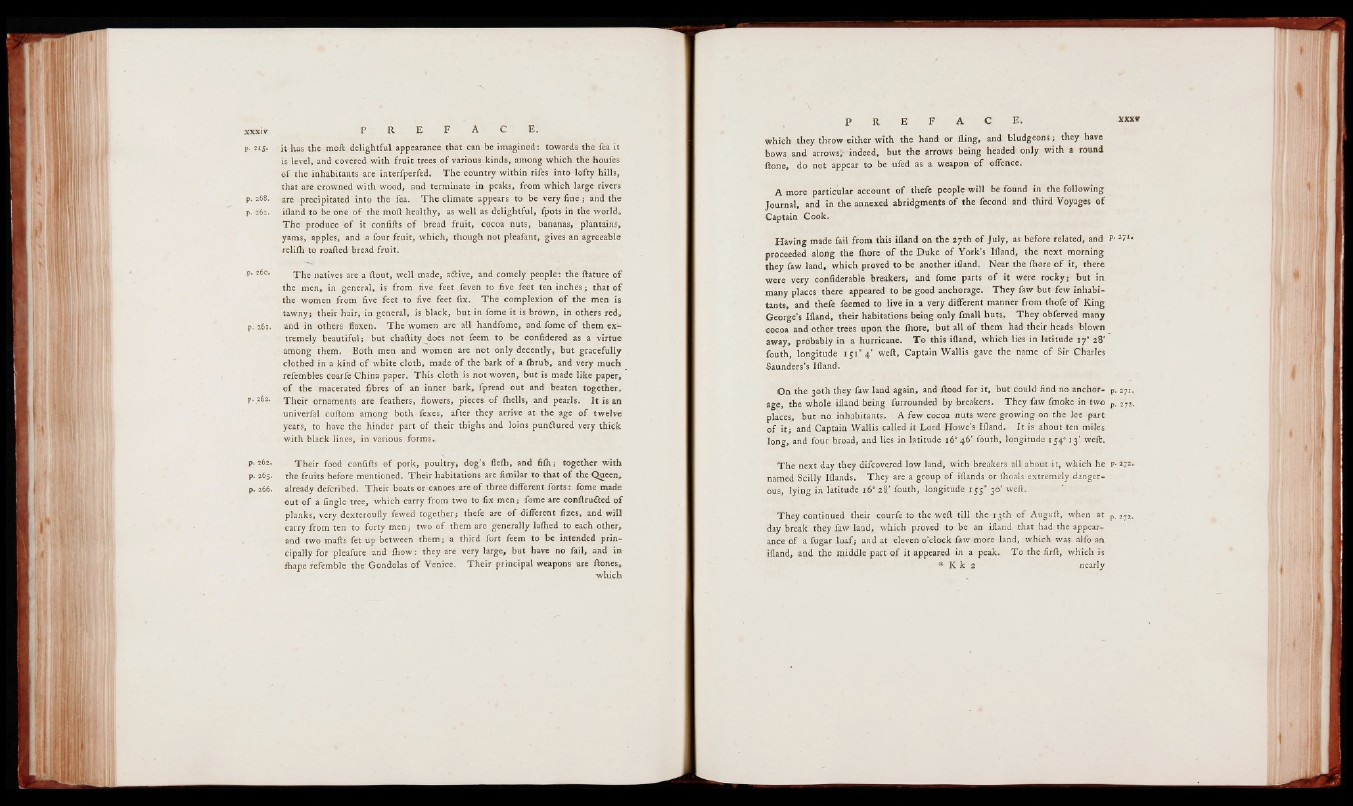
it has the moft delightful appearance that can be imagined: towards the fea it
is level, and covered with fruit trees of various kinds, among which the houfes
of the inhabitants are interfperfed. The country within rifes into lofty hills,
that are crowned with wood, and terminate in peaks, from which large rivers
are precipitated into the fea. The climate appears to be very fine; and the
ifiand to be one of the moil: healthy, as well as delightful, fpots in the world.
The produce o f it confiils of bread fruit, cocoa nuts, bananas, plantains,
yams, apples, and a four fruit, which, though not pleafant, gives an agreeable
reliih to roafted bread fruit.
The natives are a ftout, well made, attive, and comely people: the ftature of
the men, in general, is from five feet feven to five feet ten inches ; that of
the women from five feet to five feet fix. The complexion of the men is
tawnyj their hair, in general, is black, but in fome it is brown, in others red,
and in others flaxen. The women are all handfome, and fome of them extremely
beautiful; but chaility does not feem to be confiderecL as a virtue
among them. Both men and women are not only decently, but gracefully
clothed in a kind of white cloth, made of the bark of a fhrub, and very much
refembles coarfe China paper. This cloth is not woven, but is made like paper,
of the macerated fibres of an inner bark, fpread out and beaten together.
Their ornaments are feathers, flowers, pieces of fhells, and pearls. It is an
univerfal cuftom among both fexes, after they arrive at the age of twelve
years, to have the hinder part of their thighs and loins pundlured very thick
with black lines, in various forms.
Their food confifts of pork, poultry; dog’s fleih, and fifh; together with
the fruits before mentioned. Their habitations are fimilar to that of the Queen,
already defcribed. Their boats or canoes are o f three different forts: fome made
out of a fingle tree, which carry from two to fix men; fome are conftru&ed of
planks, very dexteroufly fewed together; thefe are of different fizes, and will
carry from ten to forty men; two of them are generally lafhed to each other,
and two mails fet up between them; a third fort feem to be intended principally
for pleafure and ihow: they are very large, but have no fail, and in
fhape referable the Gondolas of Venice. Their principal weapons are ftones,
which
which they throw either with the hand or fling, and bludgeons; they have
bows and arrows?* indeed, but the arrows being headed only with a round
ftone, do not appear to be ufed as a weapon o f offence.
A more particular account of thefe people will be found in the following
Journal, and in the annexed abridgments of the fecond and third Voyages of
Captain Cook.
Having made fail from this ifland on the 27th of July, as before related, and P* 27Id
proceeded along the (hore of the Duke of York’s Ifland, the next morning
they faw land, which proved to be another ifland. Near the fhore o f it, there
were very confiderable breakers, and fome parts o f it were rocky; but in
many places there appeared to be good anchorage. They faw but few inhabitants,
and thefe feemed to live in a very different manner from thofe of King
George’s Ifland, their habitations being only fmall huts'. They obferved many
cocoa and other trees upon the fhore, but all o f them had their heads blown _
away, probably in a hurricane. To this ifland, which lies in latitude 17* 28'
fouth, longitude 151° 4’ weft, Captain Wallis gave the name of Sir Charles
Saunders’s Ifland.
On the 30th they faw land again, and ftood for it, but could find no anchor- p. 271.
age, the whole ifland being furrounded by breakers. They faw fmoke in two p. 272.
places, but no inhabitants. A few cocoa nuts were growing on the lee part
o f it; and Captain Wallis called it Lord Howe’s Ifland. It is about ten miles
long, and four broad, and lies in latitude i 6°46’ fouth, longitude 154° 13’ weft.
The next day they difcovered low land, with breakers all about it, which he P- 272.
named Scilly Iflands. They are a group of iflands or ihoals extremely dangerous,
lying in latitude 160 28/ fouth, longitude 1550 30’ weft.
They continued their courfe to the weft till the 13 th of Auguft, when at p. 272.
day break they faw land, which proved to be an ifland that had the appearance
of a fugar loaf; and at eleven o’clock faw more land, which was al fo a n
ifland, and the middle part of it appeared in a peak. To the firft, which is
* K k 2 nearly